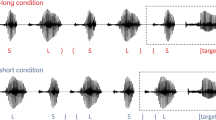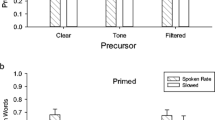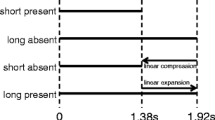Abstract
The perceptual compensation effect between neighboring speech segments is measured in various word contexts to explore the following two problems: (1) whether temporal modifications of multiple segments perceptually affect each other, and (2) which aspect of the stimulus correlates with the perceptually salient temporal markers. Experiment 1 utilizes an acceptability rating of temporal unnaturalness for words with temporal modifications. It shows that a vowel (V) duration and its adjacent consonant (C) duration can perceptually compensate each other. This finding demonstrates the presence of a time perception range wider than a single segment (V or C). The results of the first experiment also show that rating scores for compensatory modification between C and V do not depend on the temporal order of modified pairs (C-to-V or V-to-C) but rather on the loudness difference between V and C; acceptability decreases when the loudness difference between V and C becomes high. This suggests that perceptually salient markers locate around major loudness jumps. Experiment 2 further investigates the influence of the temporal order of V and C by utilizing a detection task instead of the acceptability rating.
Access this chapter
Tax calculation will be finalised at checkout
Purchases are for personal use only
Preview
Unable to display preview. Download preview PDF.
Similar content being viewed by others
References
W. N. Campbell. Multi-level timing in speech. PhD thesis, University of Sussex, Department of Experimental Psychology, 1992. Available as ATR Technical Report TR-IT-0035.
R. Carlson and B. Granström. Perception of segmental duration. In A. Cohen and S. G. Nooteboom, editors, Structure and process in speech perception, pp. 90–106. Heidelberg: Springer-Verlag, 1975.
W. N. Campbell and Y. Sagisaka. Moraic and syllable-level effects on speech timing. Technical Report SP 91–107, IEICE, 1991.
G. Fant and A. Kruckenberg. Preliminaries to the study of Swedish prose reading and reading style. Technical Report 2, Royal Institute of Technology, 1989.
H. Fujisaki, K. Nakamura, and T. Imoto. Auditory perception of duration of speech and non-speech stimuli. In G. Fant and M. A. A. Tatham, editors, Auditory Analysis and Perception of Speech, pp. 197–219. London: Academic Press, 1975.
D. M. Green and J. A. Swerts. Signal Detection Theory and Psychophysics. New York: John Wiley, 1966.
N. Higuchi and H. Fujisaki. Durational control of segmental features in connected speech. Technical Report S80–40, Acoust. Soc. Jpn., 1980. in Japanese with English abstract..
M. Hoshino and H. Fujisaki. A study on perception of changes in segmental durations. Technical Report H83–8/S82–75, 1983.
S Hiki, Y. Kanamori, and J. Oizumi. On the duration of phonemes in running speech. Journal of the Institute of Electrical Communication Engineers of Japan, 50:849–856, 1967. in Japanese.
A. W. F. Huggins. Just noticeable differences for segment duration in natural speech. J. Acoust Soc. Am., 51 (4): 1270–1278, 1972.
A. W. F. Huggins. On the perception of temporal phenomena in speech. J. Acoust Soc. Am., 51(4):1279–1290, 1972.
S. Imai and T. Kitamura. Speech analysis synthesis system using the log magnitude approximation filter. Trans. Institute of Electronics and Communication Engineers, J61-A:527–534, 1978. in Japanese with English figure captions.
ISO. Acoustics-method for calculating loudness level. International Organization for Standardization, ISO 532–1975(E), 1975.
D. H. Klatt. Linguistic uses of segmental duration in English: acoustic and perceptual evidence. J. Acoust Soc. Am., 59:1208–1221, 1976.
N. Kaiki and Y. Sagisaka. The control of segmental duration in speech synthesis using statistical methods. In E Vatikotis-Bateson, Y Tohkura, and Y Sagisaka, editors, Speech Perception, Production and Linguistic Structure, pp. 391–402. Ohmsha (Tokyo)/ IOS Press (Amsterdam), 1992.
H. Kato and M. Tsuzaki. Intensity effect on discrimination of auditory duration flanked by preceding and succeeding tones. J. Acoust. Soc. Japan (E), 15(5):349–351, 1994.
H. Kato and M. Tsuzaki. Temporal discrimination of part of tone marked by two amplitude changes — comparison among on-marker and off-marker, and their combinations. Proceedings of the Fall meeting of Acoustics Society Japan, pp. 555–556, 1994.
N. Kaiki, K. Takeda, and Y. Sagisaka. Linguistic properties in the control of segmental duration for speech synthesis. In G. Bailly, C. Benoît, and T. R. Sawallis, editors, Talking Machines: Theories, Models, and Designs, pp. 255–263. Amsterdam: Elsevier Science, 1992.
SAS Institute Inc. The GLM procedure, SAS/STAT User’s Guide edition, 1990.
H. Sato. Segmental duration and timing location in speech. Technical Report S77–31, 1977. in Japanese with English abstract and English figure captions.
H. Sato. Some properties of phoneme duration in Japanese nonsense words. Proceedings of the Fall Meeting of Acoustics Society Japan, pp. 43–44, 1977. in Japanese with English figure captions.
H. H. Schulze. The detectability of local and global displacements in regular rhythmic patterns. Psychological Research, 40:173–181, 1978.
Y. Sagisaka and Y. Tohkura. Phoneme duration control for speech synthesis by rule. Transactions of the Institute of Electronics, Information and Communication Engineers of Japan, J67-A(7):629–636, 1984.
Y. Sagisaka, K. Takeda, M. Abe, S. Katagiri, T. Umeda, and H. Kuwabara. A large-scale Japanese speech database. In Proceedings of the International Conference on Spoken Language Processing, Kobe, Japan, pp. 1089–1092, 1990.
W. S. Torgerson. Theory and Methods of Scaling. New York: John Wiley, 1958.
K. Takeda, Y. Sagisaka, and H. Kuwabara. On sentence-level factors governing segmental duration in Japanese. J. Acoust Soc. Am., 89:2081–2087, 1989.
J. P. H. van Santen. Contextual effects on vowel duration. Speech Communication, 11:513–546, 1992.
E. Zwicker, H. Fastl, U. Widmann, K. Kurakata, S. Kuwano, and S. Namba. Program for calculating loudness according to DIN 45631 (ISO 532b). J. Acoust Soc. Japan (E), 12(l):39–42, 1991.
Editor information
Editors and Affiliations
Rights and permissions
Copyright information
© 1997 Springer-Verlag New York, Inc.
About this chapter
Cite this chapter
Kato, H., Tsuzaki, M., Sagisaka, Y. (1997). Measuring temporal compensation effect in speech perception. In: Sagisaka, Y., Campbell, N., Higuchi, N. (eds) Computing Prosody. Springer, New York, NY. https://doi.org/10.1007/978-1-4612-2258-3_16
Download citation
DOI: https://doi.org/10.1007/978-1-4612-2258-3_16
Publisher Name: Springer, New York, NY
Print ISBN: 978-1-4612-7476-6
Online ISBN: 978-1-4612-2258-3
eBook Packages: Springer Book Archive




